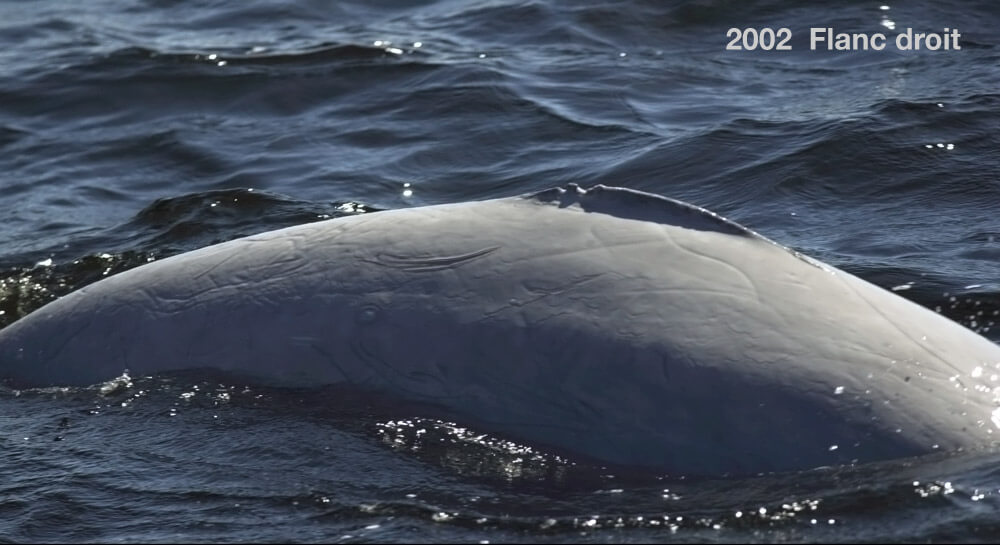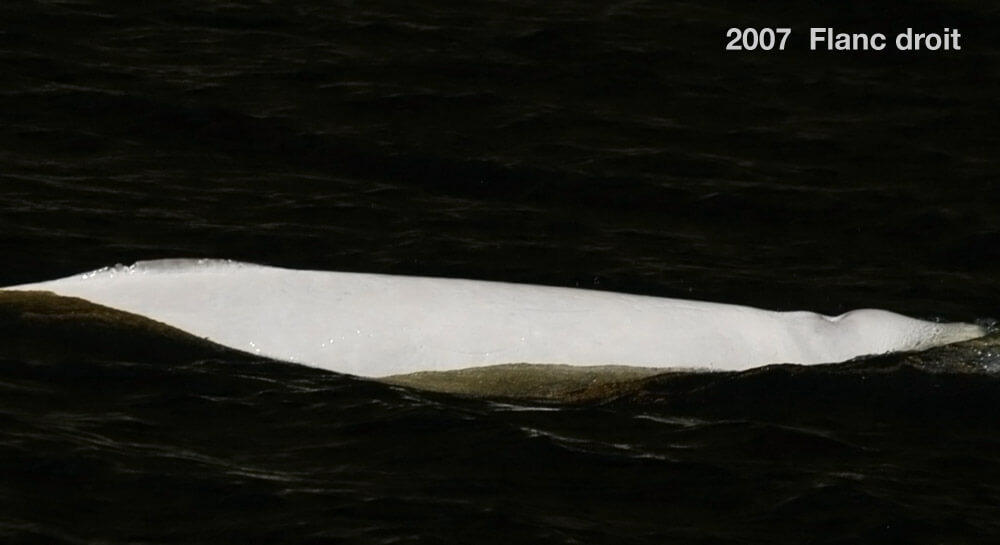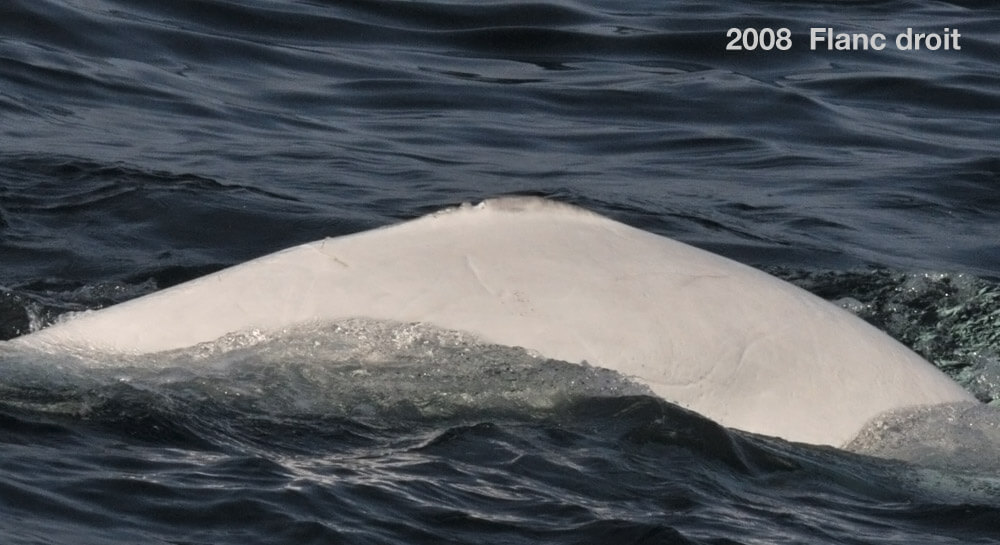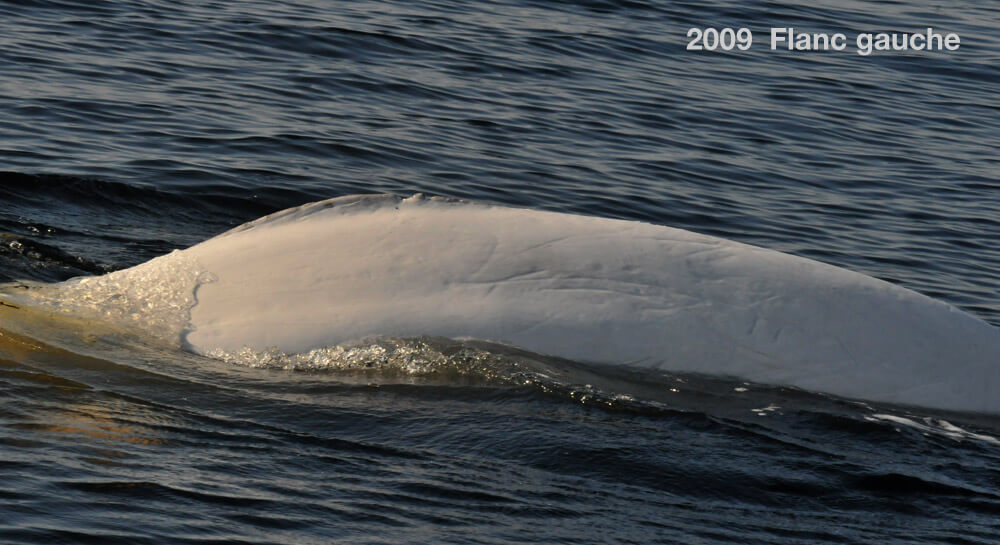AL
Beluga

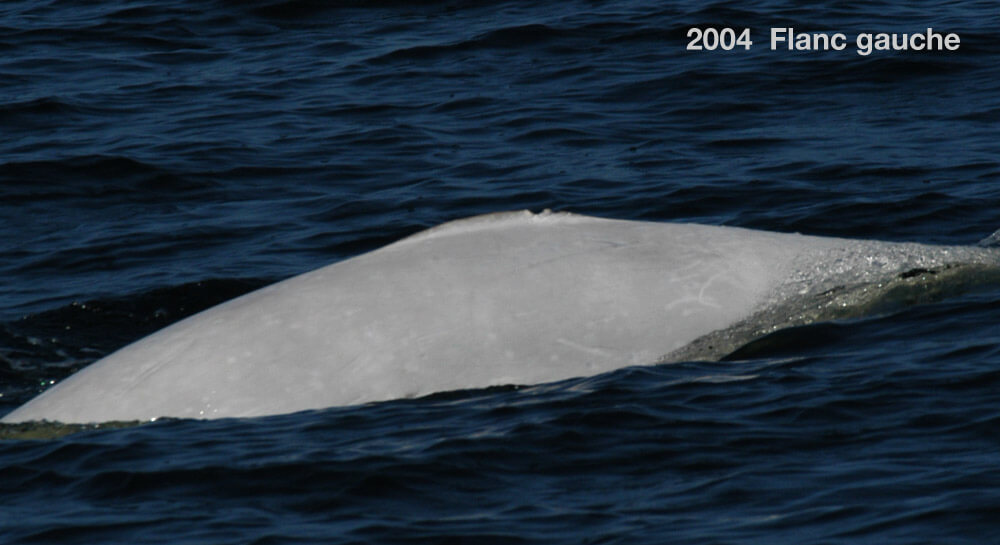
Adopted by Les Bières Bélugas Ltée
-
ID number
DL1881
-
Sex
Presumed male
-
Year of birth
Around 1999
-
Known Since
2002
Distinctive traits
We recognize AL thanks to a deep notch in his dorsal crest, with a smaller notch next to the first. Other small details complete the profile of his well-marked dorsal crest.
Life history
Our first encounter with AL dates back to 2002. At the time he was a juvenile beluga whale. He became progressively lighter over the years, and has been almost completely white since 2012. The monitoring of several dozen other beluga whales, like AL, has taught us that the transition to white happens around the age of 12 to 16. Thus, AL was born in the late 1990s.
During our first encounters, AL was regularly observed in herds of made up of adult and young animals. Eventually he started patronizing herds of juveniles. These were large and often very active groups. We have observed him most often in groups of adults since 2012. The evolution of these social affiliations leads us to believe that AL is a male. There is a strong segregation between adult males and females. Females live in communities with their young, while males are frequently found in same-sex herds.
For the time being, we do not yet know who AL’s faithful companions are. Adult males tend to form stable groups of associates. These alliances, which become progressively more established at the adult stage, are potentially significant to beluga whale reproductive lives.
The next chapter in AL’s story will teach us a lot about the evolution of the social lives of beluga whales. By learning how beluga whales live we will be better equipped to protect them.
Observations history in the Estuary
Years in which the animal was not observed Years in which the animal was observed
Latests news
The summer of 2016 – our 32nd season at sea with the belugas – was once again rich in encounters and surprises. Observations include sightings of Al on at least two occasions.
September 24, 2016: We’re off the coast of Cap de Bon-Desir, near the north shore of the Estuary. Around us, there are belugas everywhere! There are at least 180 individuals, including adults and a few grays, and among them we identify Al.
These large but short-lived gatherings consist essentially of males. They’re often observed in this area, i.e. the downstream sector of the summer range, between Tadoussac and Les Escoumins.
The affinity of male herds (such as those frequented by Al) for this place might be attributable to the types of prey found there. It is a deep underwater valley: the Laurentian Channel. Its rugged topography and regular upwelling (rising cold water) make it a very special area conducive to high concentrations of prey.
Off of Île Rouge, at the mouth of the Saguenay Fjord, we spot a herd of between 100 and 110 individuals. The herd is made up of mostly adults, possibly all males. Amongst them, we spot AL. We attempt a biopsy, but unfortunately the arrow passes just over his dorsal crest. It’s no easy feat, taking aim at a moving target from a platform that is also moving. We’ll have to wait for another chance to get this little piece of skin and fat that will confirm whether our suspicions as to AL’s sex are correct, in addition to perhaps revealing other secrets. In the course of this encounter, we did however manage to perform three biopsies on other belugas. A successful day!
We observe AL off the coast of L’Isle-Verte on the south shore of the St. Lawrence. He is swimming in a herd of 70 belugas. Within the herd, we notice a few entirely white individuals, but 70% of them are gray or slightly gray. It is therefore a herd of adults, but mostly composed of young adults. The belugas split into a few smaller groups of about a dozen individuals and slowly work their way up the river. The encounter with this herd ends with a successful biopsy.
We were working in Sainte-Marguerite Bay. One group of 10 animals appeared to be essentially composed of large males, while another group of seven beluga whales was made up of juveniles: what we commonly refer to as “ados”. We performed a biopsy on one of the beluga whales in AL’s group. Around 10:00 a.m. the animals became quite active and began behaving in a manner typical for this particular bay: tails and heads started popping up above the surface. We managed a second biopsy on a second individual. We left the group of 30 individuals late in the morning.
AL is spotted in the Saguenay Fjord in a herd of about 20 individuals. He is swimming in a group of young belugas that we’ve nicknamed the “teenagers”. They are highly dynamic. One of these individuals, as soon as it comes up for air, greets us with vocalizations that can be heard at the surface. All of this excitement is difficult to make sense of. Until we can unlock the life mysteries of belugas, we place these behaviours in the broad category of “social activities”.
September 21, 2012: We are on board the Bleuvet, off the coast of Trois-Pistoles. Around us is a herd of about fifty belugas, all white adults. Among them is Al, who is swimming with Splash. Not far from us is also a herd of about fifteen gray seals, in the middle of which suddenly appears a minke whale. The presence of so many animals suggests that there is a large concentration of fish below us.
The belugas are swimming in single file and moving upstream. We take this opportunity to perform a biopsy on one beluga that shows a gray spot.
Sometimes it seems that belugas simply want to make our day and gather in groups of “celebrities”. That’s precisely what happened to us that day. No sooner do we leave the Tadoussac marina aboard the Bleuvet (our research boat), when we cross paths with a herd of about fifty belugas calmly moving toward the south shore. The herd consists of adults and juveniles as well as one calf, i.e. a beluga born earlier in the year.
We position our boat at the tail end of the herd to observe belugas that are smaller in size. Since they are white, we know they are all adults, but they could be females. We photograph the animals and manage to recognize a nice collection of stars from our family album: AlbioriX, Frimas, DL014, Nics, Miss Frontenac, Or Blanc, Al, Elle and DL173. When Al dives, he resurfaces 200-300 metres away, followed by other belugas. These repetitive, equally-spaced dives are a behaviour that we witness frequently in the mouth of the fjord. It was a constructive encounter that will help us add pages to our album.
Sponsors
Les Bières Béluga Ltée adopted AL (2015).
WHO TAKES BEER, TAKES CONSCIENCE!
The three Bières Bélugas are available at some fifty points of sale in Montreal and Quebec City, and are now distributed by the majority of shopkeepers in the village of Tadoussac. These three beers were created to contribute to the research and conservation of St. Lawrence belugas. For each beer sold, $0.11 is donated to Projet Béluga as part of the Adopt a Beluga campaign.
The beers are the brainchild of Bières Béluga Ltée founders Patrick Cool, Frédérick Jodoin and Eric Buteau. “We wanted to create a beer at a time when we were hearing a lot about beluga whales in the media. We found Quebec brewers with the ability and desire to develop quality beers, while contributing to an environmental cause,” explains Mr. Cool.
The first Bières Béluga is a Golden Ale (launched in spring 2015), the second is a Maple Scotch Ale (launched in fall 2015) and the third is a Raspberry White (launched in spring 2016).
Find out more :

